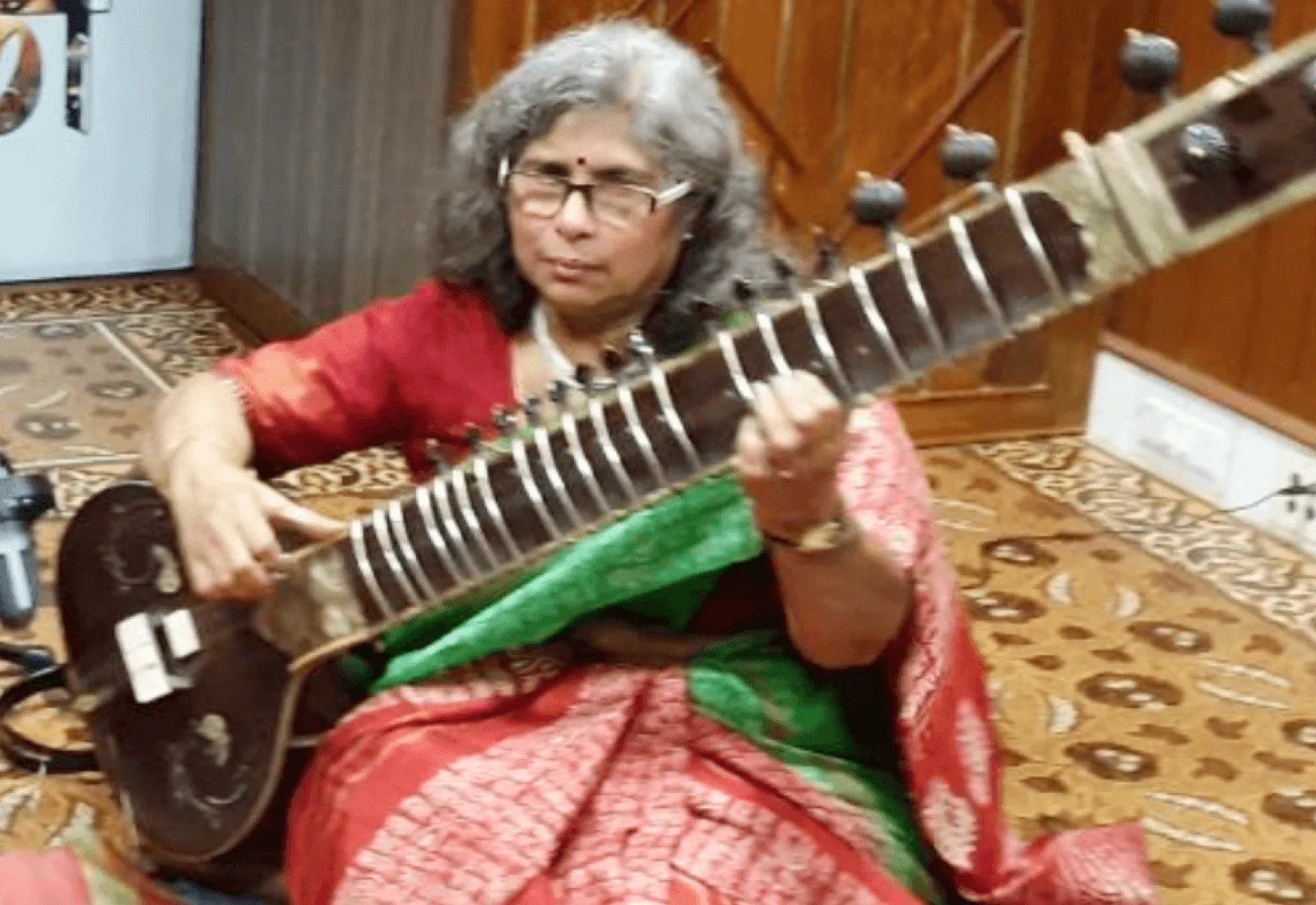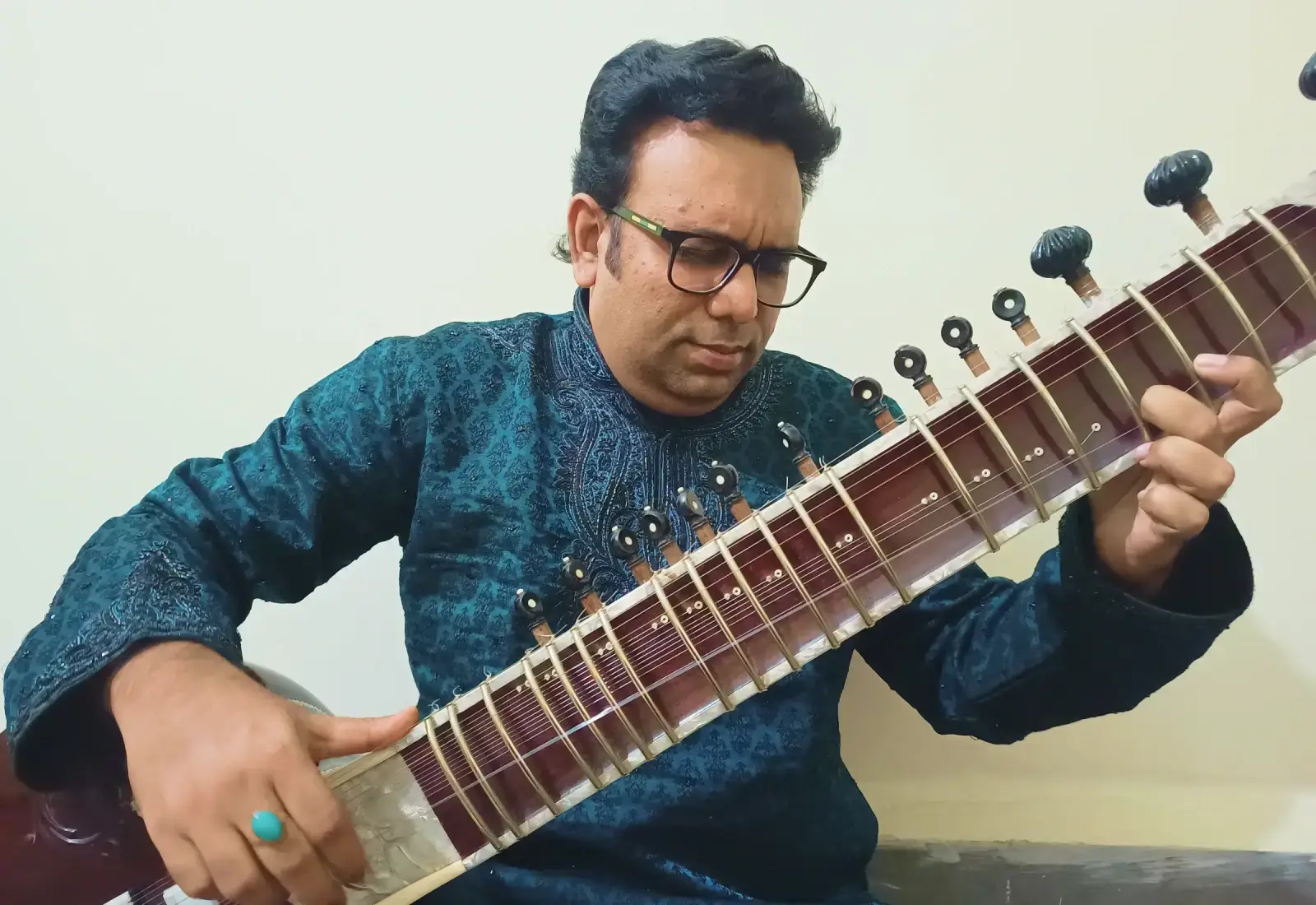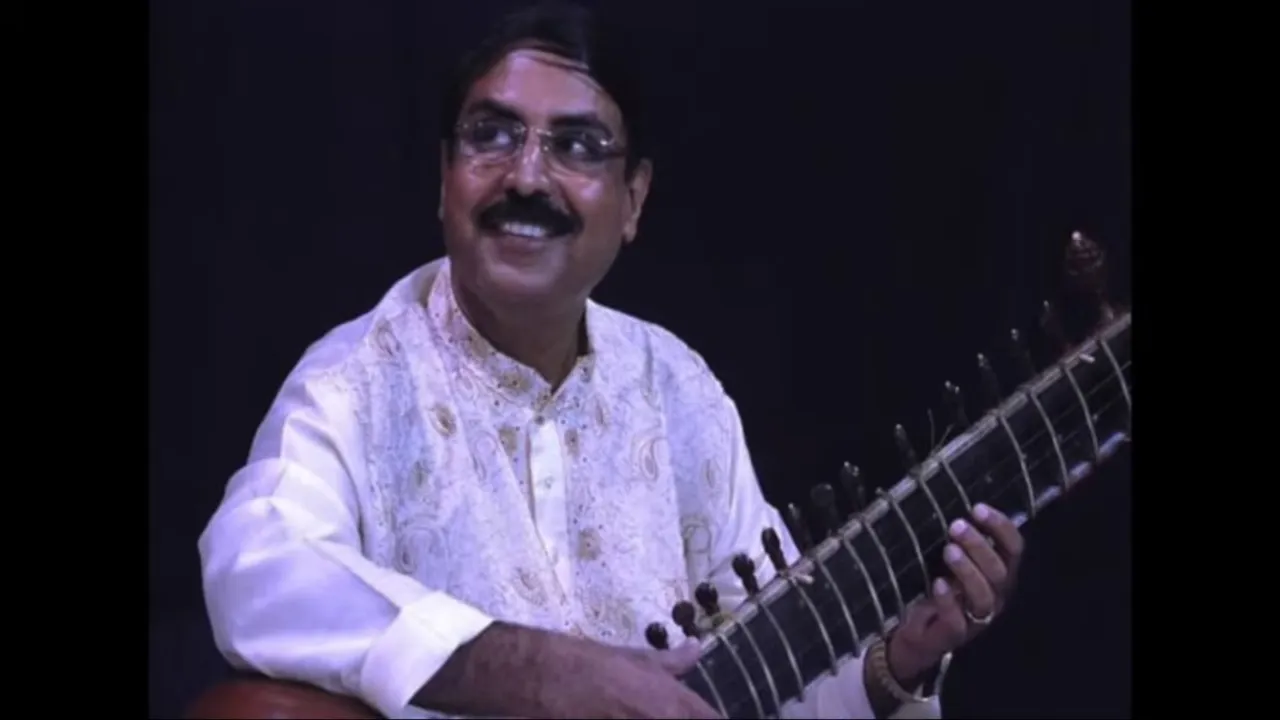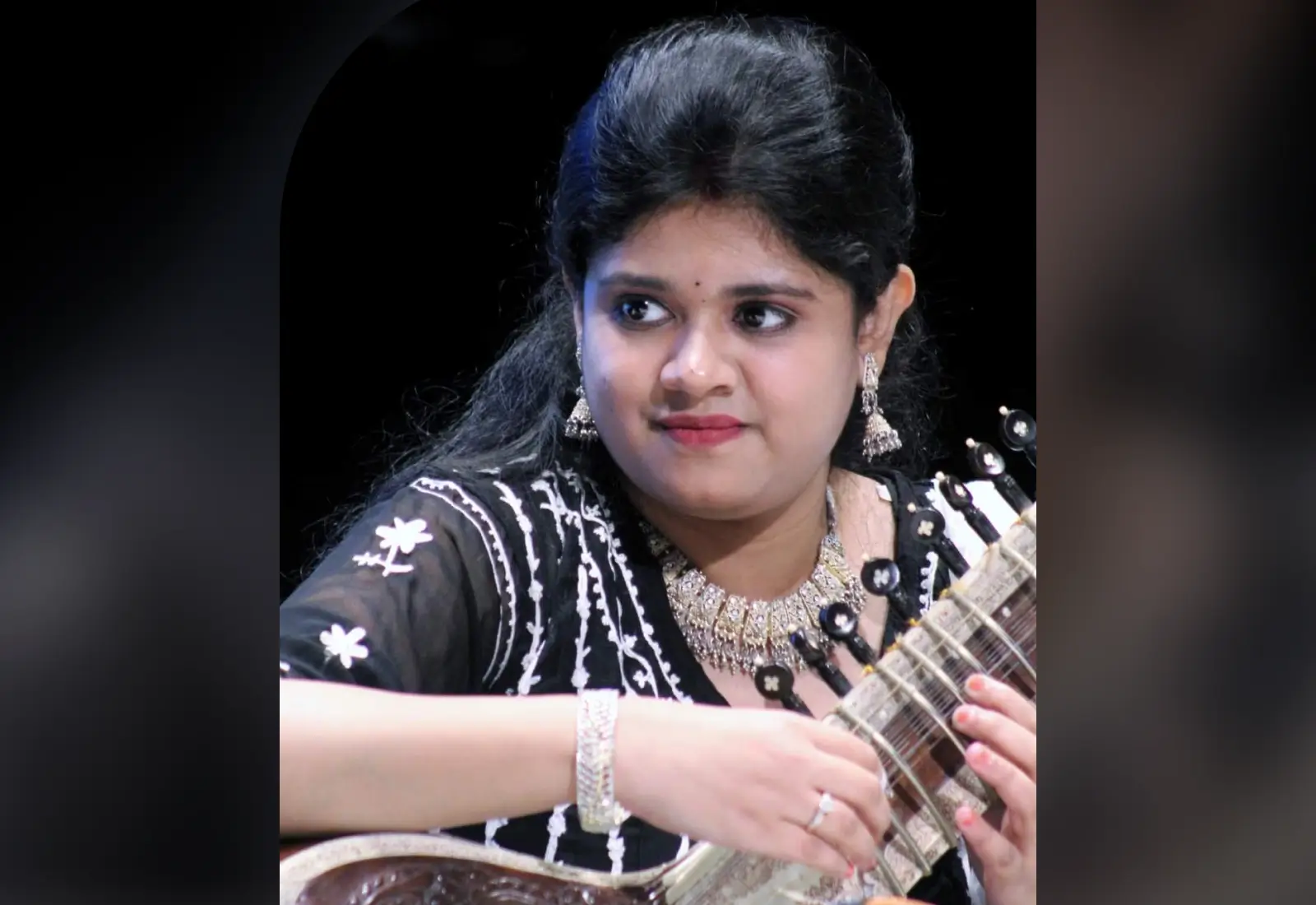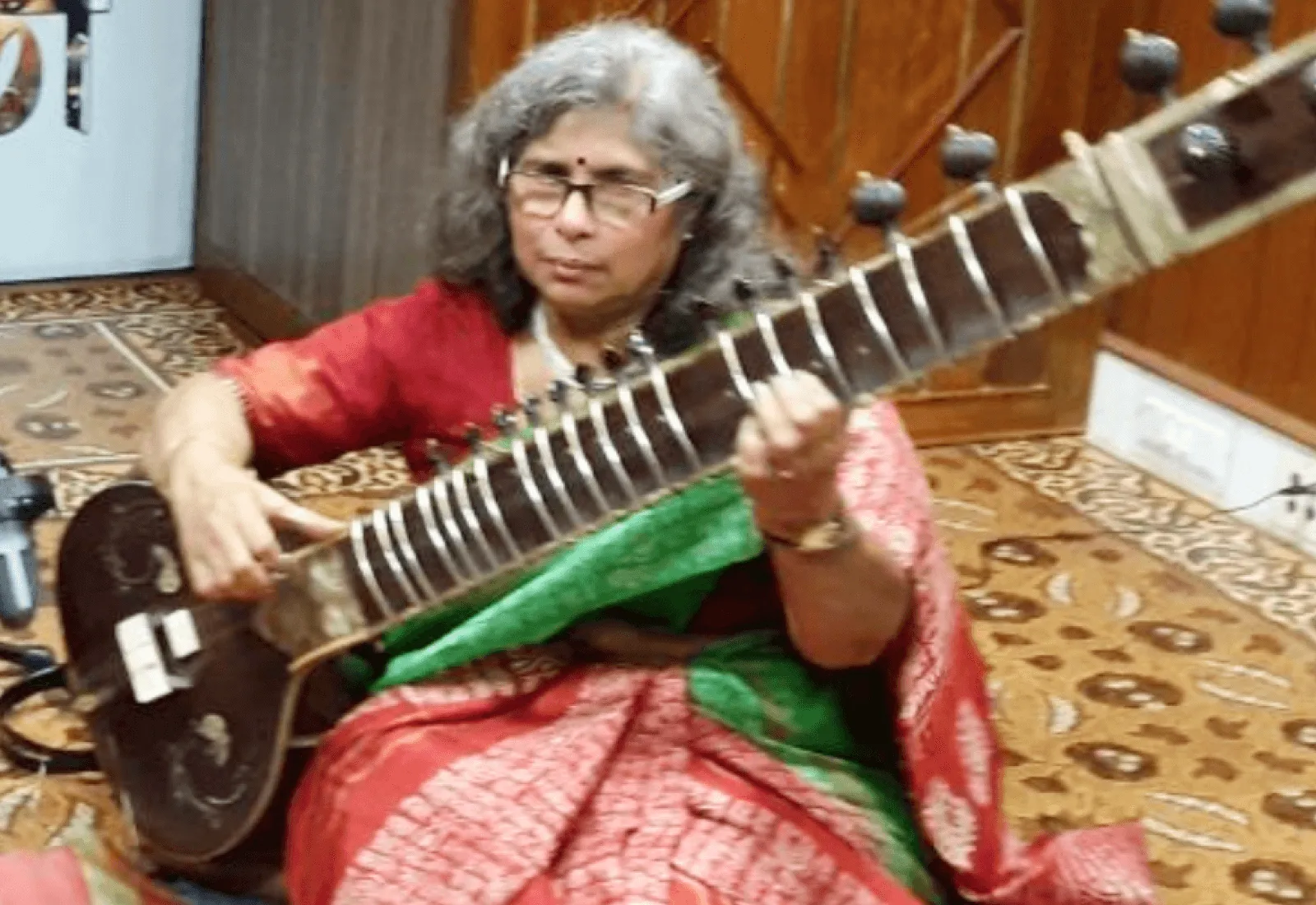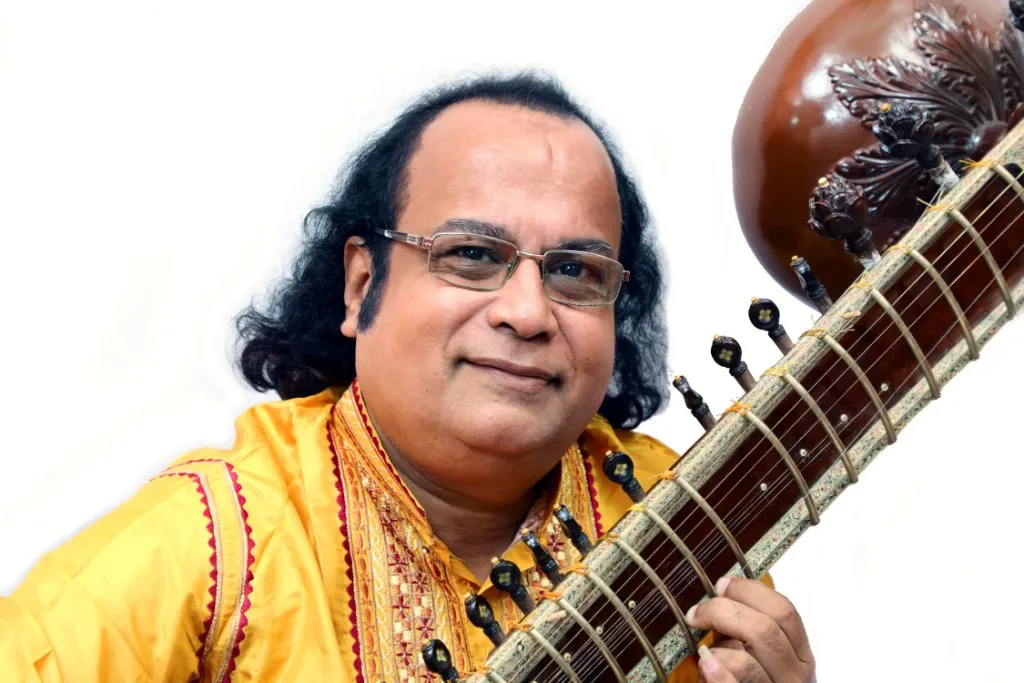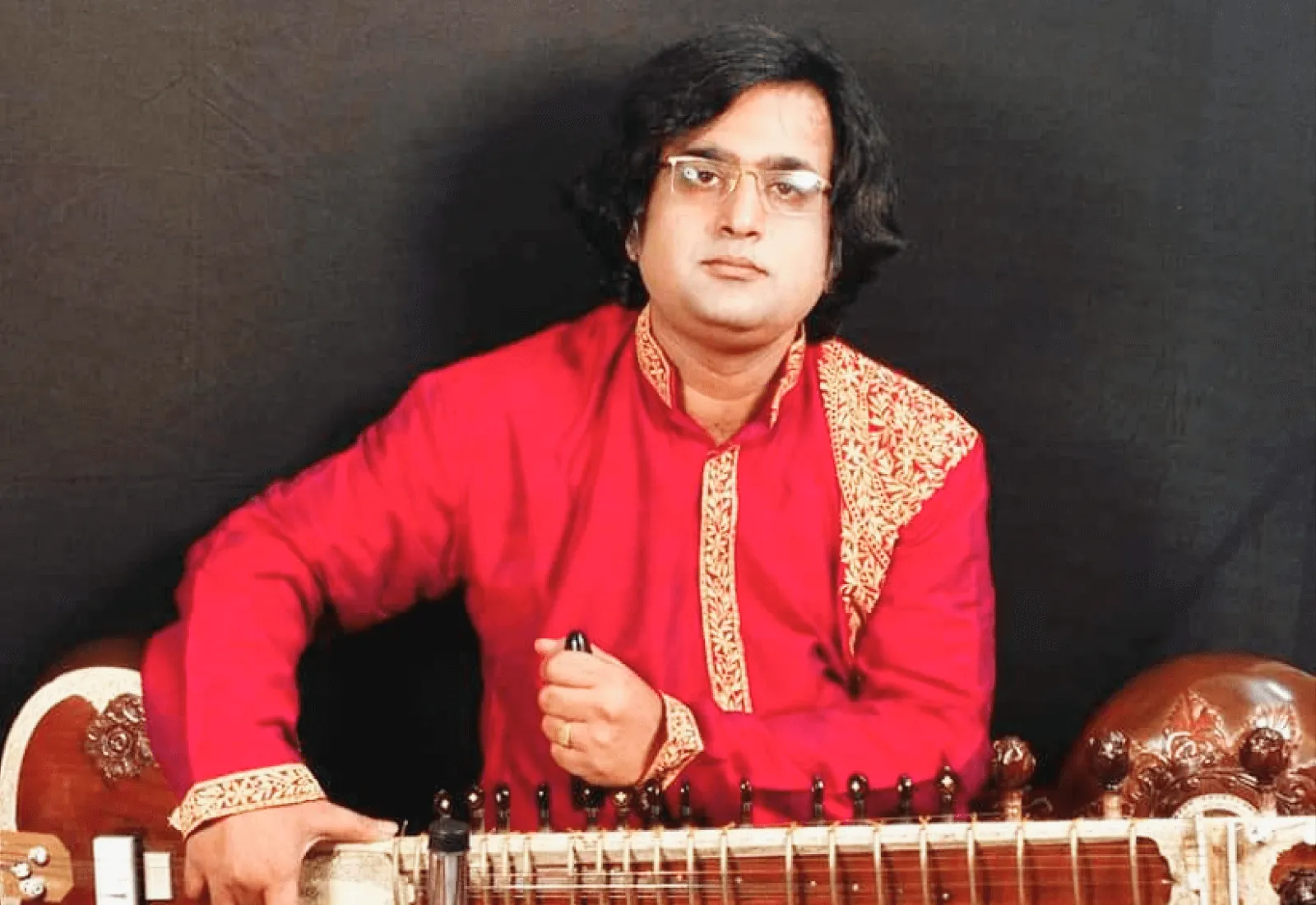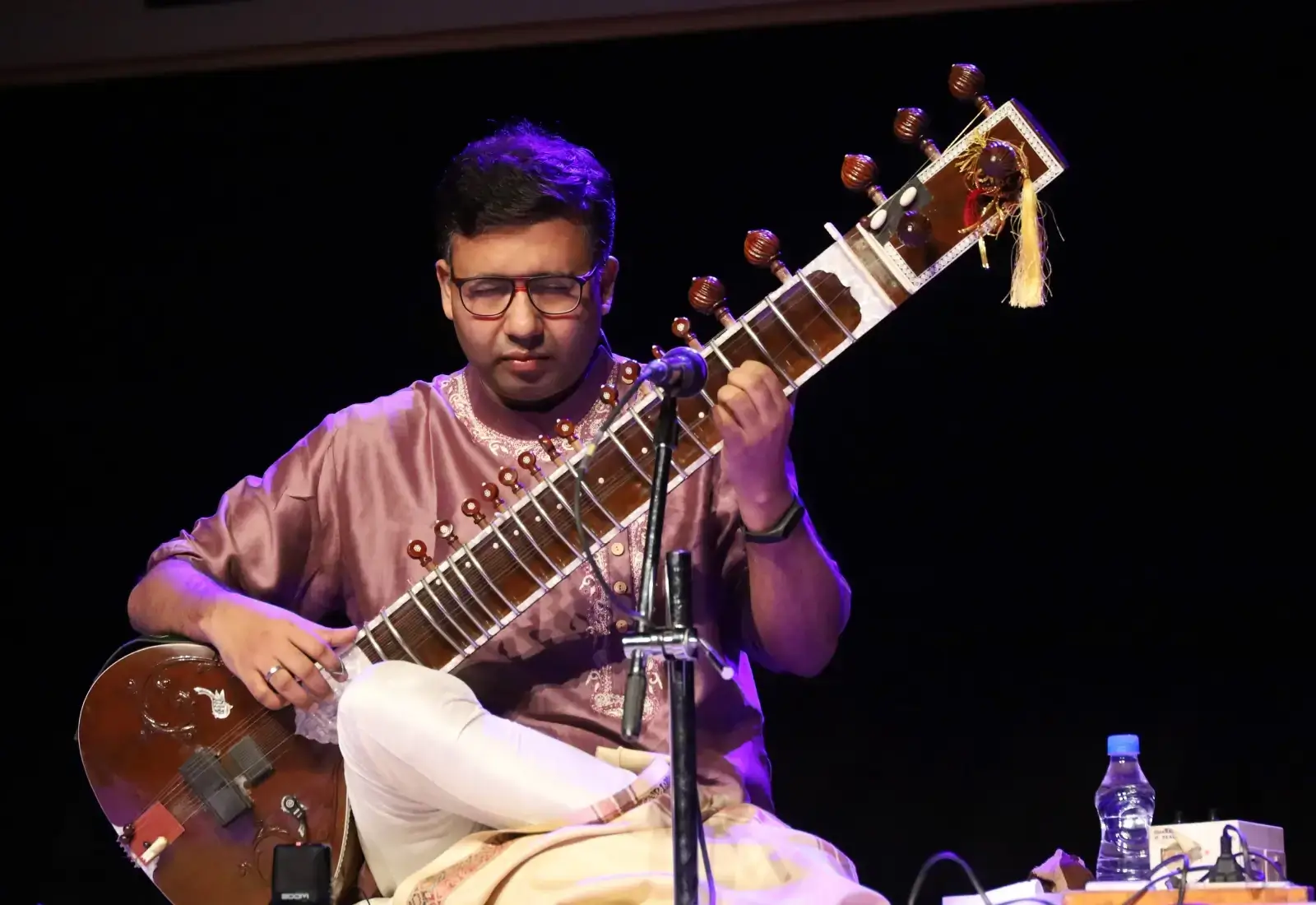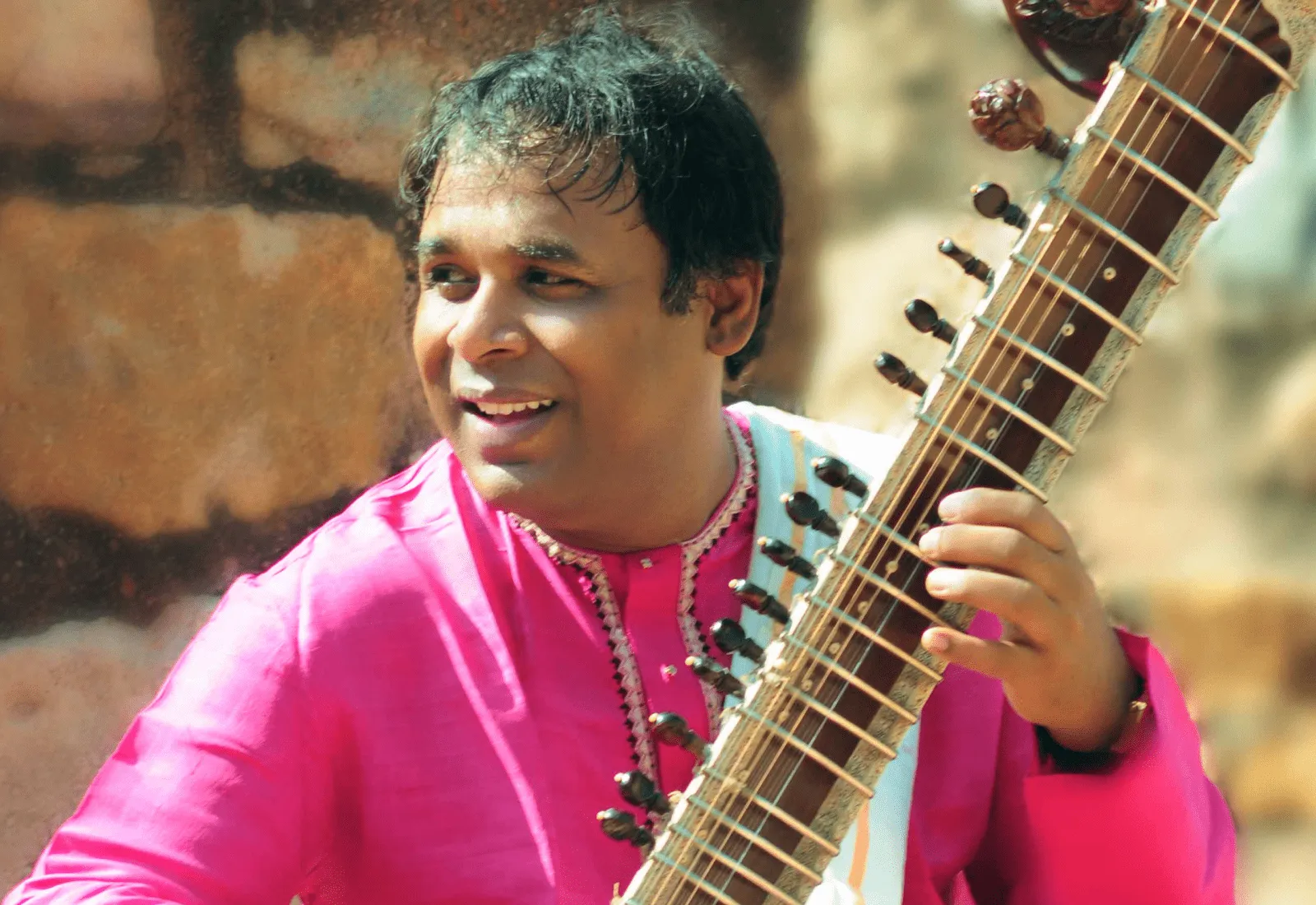What is Sitar?
Sitar is a plucked string instrument popularized by Hindustani classical music. The Sitar instrument is typically 1.2 meters, or four feet, in length and is played sitting down with the instrument held at a 45-degree angle. The body of the instrument is a hollow pear shape made from a gourd with a long, wide, hollow neck. Sitars can have between 18 and 21 strings that are attached to side- and front-tuning pegs at one end and to one of two bridges at the other.
Sitar strings are made from wire of varying gauges. There are typically five to seven main strings in Sitar that run along the raised, moveable frets on the neck of the instrument. There are also one or two drone strings used for rhythm and 10-13 sympathetic, or taraf, strings beneath the frets. Sympathetic strings vibrate independently when the main strings are played and produce a harmonic sound. The largest bridge, badaa goraa, is attached to the main strings and the drone strings, while a smaller bridge, chota goraa, is for the sympathetic strings.
Sitars are often made from seasoned toon wood or teak. The resonator(s) are made from gourd—either pumpkin, calabash, or a wood replica. Bridge styles and materials vary depending on the preference of the musician or instrument maker. The same is true of the tabli, or soundboard. Altering the bridge to affect the quality of sound is called jawari, and is often achieved by filing down the bridge to a specific curve.
Originating in and popular throughout India, the sitar gained wider recognition in the 1950s through the music of famous sitar exponent Pandit Ravi Shankar. From the mid-20th century on, the sitar influenced worldwide rock, jazz, and pop music. In addition to sitars now being seen in multiple musical genres, many string instruments are tuned to imitate the sitar.
History of Sitar Instrument
The sitar instrument was developed in the 1700s following the Mughal Empire, taking elements from the instruments Veena, Sehtar, and Tanpura that were popular at the time. The instrument was also inspired by long neck lutes that originated from Central Asia. Following its inception, the instrument gained popularity in Hindustani and Carnatic music, achieving its modern form in the 18th century.
The origin of the sitar we know today is credited to Amir Khusrau, an 18th-century fakir. Khusrau’s grandson, Masit Khan, continued his grandfather’s influence on the sitar and its music. The playing style of Masitkhani Gat was named for his slow, melodic compositions that influenced much of early sitar music. In the 19th century, the sitar underwent design changes by Amrit and Rahim Sen that are still in use today.
The 20th century saw significant changes to the sitar, namely the two distinct instrument types named for modern Sitar pioneers. The Ravi Shankar and the Vilayat Khan are both similar but have key differences that can be found in the next section. Additionally, an electric sitar was developed in the 1960s and is typically used in pop, rock, and jazz music.
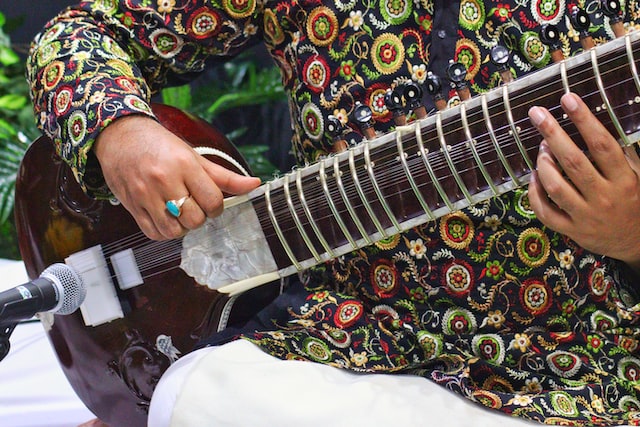
Types of Sitar
There are two types of Sitar musical instruments, each named after a famous sitar player from the 20th century. In addition to these two main types of Sitars, there are countless variations and individualized instruments, both in construction and decorative design, as well as bass and electric Sitars.
The first type is an instrumental style named for Ravi Shankar (RV). These sitars feature a second resonator made from a smaller gourd that is located at the top of the neck, and attached to the back of the instrument. The RV is typically fully decorated with carvings and inlays and features extra bass strings, which produce a deeper sound.
The second is a Gayaki-style Sitar, called a Vilayat Khan (VK). The VK sitar is smaller, less ornamental, and features just one resonator gourd. The VK also has fewer sympathetic strings and no bass strings. This type of sitar has an additional string called a chickaree, which produces a rhythmic accompaniment. The Vilayat Khan sitar is favored by the Etawa Gharana school of sitar playing.
The bass sitar, or surbahar, is larger than the two traditional types of sitars and uses thicker strings that produce a lower sound. The bass sitar has a wider neck and fretboard, allowing for the larger strings to be played without interference from the other strings. The electric sitar is not technically a sitar. The instrument is actually an electric guitar that has a special bridge and sympathetic strings that allow it to mimic the sound of a sitar.
Parts of Sitar
1. Kunti (Tuning Pegs)
Material: Crafted from seasoned hardwood like tun or rosewood.
Function: Used to tune the strings by adjusting tension.
Check for Quality: Ensure each peg fits securely and turns smoothly without slipping. Avoid instruments with plastic or poorly shaped pegs.
2. Mool (Headstock)
Material: Typically made from the same hardwood as the neck.
Function: Houses the main pegs and balances string tension.
Check for Quality: Look for solid construction with no cracks around the peg holes. The wood should feel firm and stable.
3. Dandi (Neck)
Material: Hollowed hardwood, often tun, to allow for sound vibration while keeping the instrument light.
Function: Forms the main playing surface where frets and strings are placed.
Check for Quality: The neck should be straight and resonant. Avoid warping or rough, unfinished surfaces.
4. Pardas (Frets)
Material: Made of brass or bronze.
Function: Control pitch when strings are pressed against them; their curved shape allows note bending.
Check for Quality: Frets should be well-polished, firmly tied, and correctly spaced. Avoid rusted or misaligned frets.
5. Tar (Strings)
Material: High-tension steel (for playing strings) and brass or steel (for sympathetic strings).
Function: Vibrate to produce sound; the main strings are played while the sympathetic strings add tonal richness.
Check for Quality: New strings should be smooth and rust-free. Ensure sympathetic strings resonate properly when the main ones are played.
6. Tabli (Soundboard)
Material: Thin wood layer, often from tun or teak, covering the resonator.
Function: Amplifies the sound generated by string vibrations.
Check for Quality: It should be crack-free and smooth. When tapped, it should produce a bright, clear tone.
7. Toomba (Resonator)
Material: Dried gourd (bottle gourd) reinforced with wood.
Function: Acts as the main resonating body of the instrument.
Check for Quality: Ensure the gourd is free from damage or holes. A high-quality toomba should produce a deep, mellow tone when lightly tapped.
8. Gulu (Neck Curve or Joint)
Material: Same hardwood as the neck.
Function: Connects the neck to the gourd and supports balance.
Check for Quality: It should be structurally sound with no visible splits or instability at the joints.
9. Jawari (Bridge)
Material: Traditionally made from bone, horn, or modern composites like fiber or ebonite.
Function: The bridge creates the signature buzzing sound (jawari) that defines the sitar's voice.
Check for Quality: Strings should sit evenly in smooth grooves. A well-crafted jawari produces a rich, resonant hum. Ask if recent re-jawari work has been done, as it needs periodic maintenance.
10. Mizrab (Finger Pick)
Material: Twisted wire, commonly iron or brass.
Function: Worn on the index finger to pluck strings.
Check for Quality: It should fit snugly and comfortably. The tip should be sturdy enough to strike clean notes but not damage the strings.
Sitar Playing Techniques
The Sitar is typically played while sitting with the instrument balanced between the musician’s foot and knee. Because the instrument is typically quite large, this allows the player’s hands to move freely without having to support the weight of the instrument. Players use a metal pick, or mihrab, to pluck the strings while anchoring their thumb on top of the fretboard.
Like many instruments, alternate playing techniques vary by school and individual. Some of the most common of those techniques are outlined below.
Meend, or mir, is a way for the player to glide between one note and another. Also called string bending, this technique is achieved by pushing or pulling the string against the curved fret. This creates a semitone, or half-step between one pitch and another.
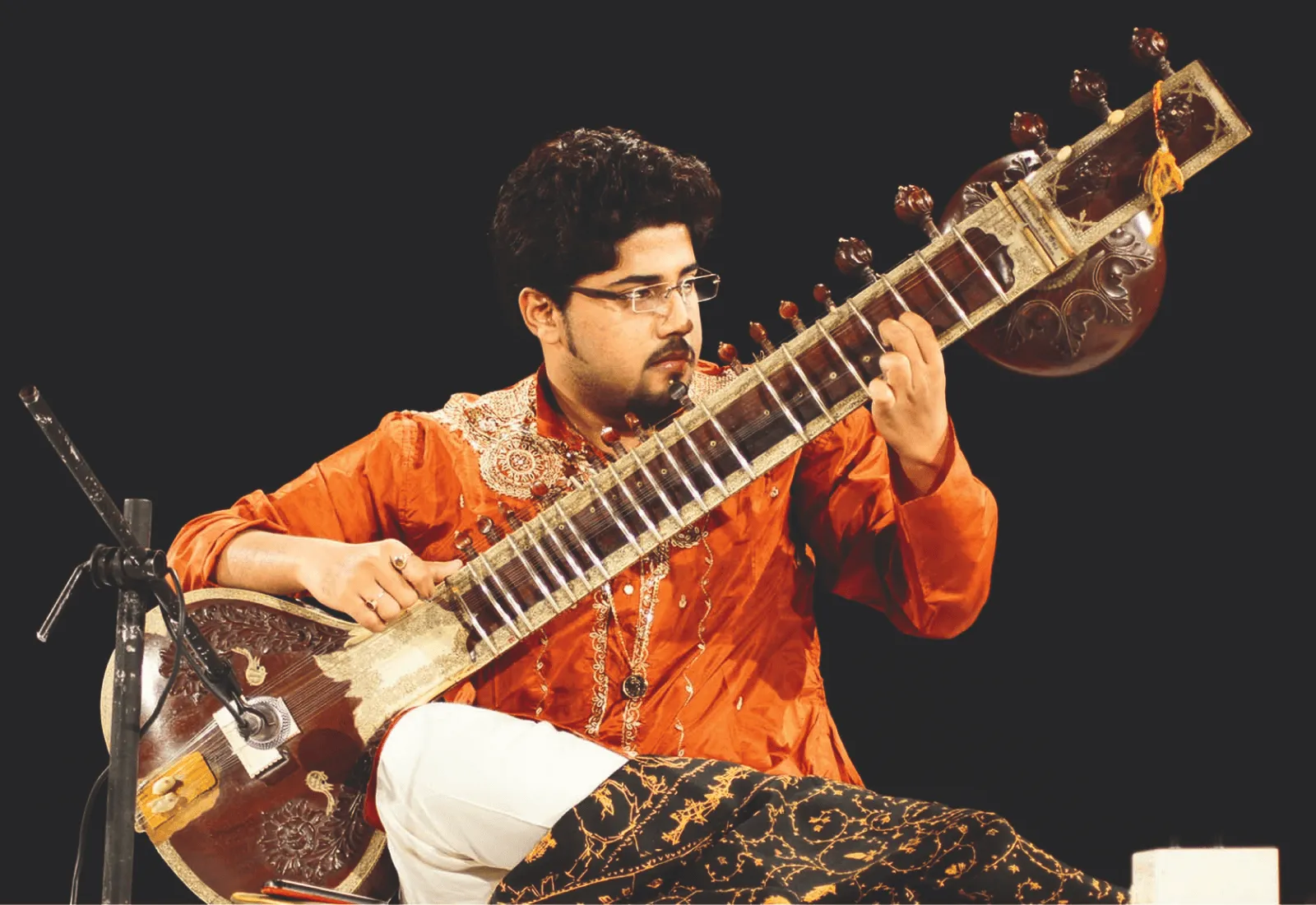
Krintan is an ornamental technique similar to a pull-off technique on a guitar. The player pulls the second finger off the string being played while holding down their index finger on the fretboard just below. This motion can be used at the beginning or end of a note and can be performed in reverse, similar to the hammer-on technique of a guitar. When this technique is done on two strings at the same time, it’s called zamzama.
A flat stroke is a technique that allows the player to strike the sympathetic strings while playing the main strings. This can be done by striking the string in a Ra stroke while allowing the mihrab to strike the sympathetic strings. This effect can also be achieved by using the pinky of the left hand to flick the sympathetic strings while playing the main strings with the right hand.
Like playing techniques, there are also different techniques for holding the instrument, individual to the player. While the most popular position is to sit on a flat surface with the legs crossed, there are other ways to hold it. The sitar can also be played while kneeling or sitting in a chair and can be modified to be played by right- or left-handed musicians.
Sitar Mechanics
The Sitar produces several different tones and pitches using different mechanics on the instrument. The melody strings can be tuned to different standards depending on the player's school, tradition, or personal preference. Sympathetic strings are tuned to the notes of the raga being played and are re-tuned for each raga. Each string is attached to a tuning peg that can be tightened to raise the pitch or loosened to lower it. The melody strings can be further fine-tuned by sliding a bead on each string near the bridge.
Additionally, the curved, metal frets along the neck of the sitar are tied on, making them moveable. The frets can be positioned to achieve one of the widest varieties of pitches of any string instrument. Drone strings are typically tuned to one pitch that is played continuously throughout a piece.
Top Famous Sitar Players
Here are some of the best Sitar players:
1. Anoushka Shankar
2. Anupama Bhagwat
3. Asit Kumar Banerjee
4. Gabby La La
5. Gaurav Mazumdar (View his course)
6. Prabir Bhattacharya (View his course)
7. Prem Joshua
8. Soumyajit Paul
9. Subrata De (View his course)
10. Supratik Sengupta (View his course)
11. Viram Jasani
12. Smarajit Sen (View his Course)
13. Ramprapanna Bhattacharya (View his Course)



